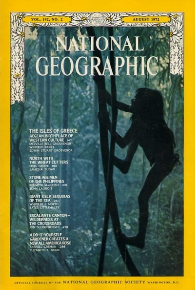A Stone’s Throw Away

The Philippine island of Mindanao is the second largest in the nation, home to 21 million people and nearly two dozen different ethnic groups, many of which are indigenous to the region. The Tasaday are one of the most notable of these indigenous tribes. The Tasaday are a stone age collection of foragers who live in a 182 km^2 (70 square mile) reserve set up for them by then-President Ferdinand Marcos in 1972. As of a 2008 census, they number about 200 people — if they exist at all, that is.
The Tasaday were first officially discovered by outsiders in 1968, when a man named Manuel Elizalde was introduced to them by a non-Tasaday tribesman on the island. At the time, the Tasaday numbered about two dozen. They were, literally, cave men and women, finding shelter in openings of larger rock formations as they never learned to build their own shelters. They were gatherers, but not very good at hunting, having never fashioned a knife. (They did, however, eat animals, such as crabs, which could be captured by hand.) Their language had no way to express that other peoples shared this world with them — or that they were even part of a world beyond the tiny area in which they lived.
Elizalde was the head and primary funder of a not-for-profit group called Panamin, whose mission was “to protect the interest of Philippine cultural minorities” per its Wikipedia entry. His report on the Tasaday, therefore, was met with great interest — especially when he relayed the news that the Tasaday had somehow lived in near-total seclusion, missing out on most technological advances that even other tribes took for granted. The existence of this culture immediately became one of the most important discoveries in the anthropological world, and soon after made the cover of National Geographic (above).
And shortly thereafter came the doubt.
There were a bunch of peculiarities which stood out to early anthropologists who visited the area. First, the Tasaday’s caves were clean — free of garbage (e.g. fish bones, crab shells, or uneaten remnants of berries and yams) or human waste. Second, the very small population showed little to no sign of inbreeding. Further, the Tasaday claimed to simply place their dead under the brush, unburied, but there were no signs of human remains anywhere. And finally, the observed diet of the Tasaday people lacked the caloric requirements to keep them healthy, but instead of finding frail people teetering on the edge of death, the anthropologists noted no such problems.
Given that more advanced tribes were only a few hours walk away, some questioned how the Tasaday managed to remain so isolated, especially in light of the above. Many started to believe that Elizalde’s discovery was a hoax, likely designed to draw attention (and dollars) to his mission. Further, skeptics believed that President Marcos’ decision to set up a reserve, and in the process, barring visitors, was a way to keep the hoax from being revealed. While reporters and researchers alike still attempted to investigate the goings-on, it proved increasingly difficult. It wasn’t until after Marcos’ ouster in 1986 that anyone could make a real dent, and by then, as a New York Times article noted, the true nature of the tribe had been colored by time.
Since then, experts and reporters have vacillated as to whether the Tasaday people are truly remnants of days long past, or whether they’re the fictional creation of a philanthropist gone mad. On August 14, 1986, ABC News’ 20/20 aired a segment titled “The Tribe that Never Was,” featuring two young members of the “tribe” who claimed to be anything but — they stated, instead, that they were members of neighboring tribes who, like the others, were part of a ruse. But later, the pair recanted, claiming that their interpreter had bribed them with cigarettes and more if they’d tell such a tale. LiveScience tells of a Swiss reporter who observed the tribe wearing blue jeans and living in huts, and to whom some tribe members admitted that their backstory was a hoax. On the other hand, in 1997, a linguistic expert from the University of Hawaii concluded (pdf) that early recordings of the Tasaday “indubitably establish the Tasaday as a distinct ethnolingusitic group,” although he later reconsidered this (pdf, again).
Unfortunately, we’ll likely never know for sure. Elizalde fled the Philippines in 1983 (returning a few years later) and was openly accused of skimming money from organizations set up to support the Tasaday. He passed away in 1997, having spent his later years insisting that he hadn’t pulled off an elaborate hoax, but due to his sullied reputation, his skeptics wouldn’t take him at his word.
Bonus Fact: Mindanao is the second largest island in the Phillipine archipelago. The largest is Luzon, which contains a lake called Taal Lake. Taal Lake contains an island called Volcano Island (the site of an active volcano which last erupted in 1977). Volcano Island contains a crater lake, seen here (that’s a satellite image). On that lake is a tiny island called Vulcan Island, seen here. Vulcan Island is an island within a lake on an island within a lake within an island.
From the Archives: The Most Isolated People in the World: The people you can’t visit because they really, really don’t want you to.
Related: “Invented Eden: The Elusive, Disputed History of the Tasaday” by Robin Hemley. One review of five stars.
